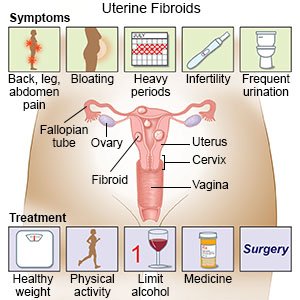Uterine Artery Embolization for Fibroids
Medically reviewed by Drugs.com. Last updated on Aug 4, 2025.
What do I need to know about uterine artery embolization (UAE) for fibroids?
UAE is a procedure to make fibroids smaller. Embolization means creating a clot, or block, in a blood vessel. Your healthcare provider will block an artery that supplies blood to the fibroid. The fibroid will not be gone but it will get smaller. This may decrease symptoms fibroids can cause. This procedure may also be called uterine fibroid embolization.
 |
How do I prepare for the procedure?
- Your provider will tell you how to prepare for this procedure. Your provider may tell you not to eat or drink anything after midnight before your procedure. Arrange to have someone drive you home and stay with you after your procedure.
- Give your provider a list of your medicines, including any herbs or supplements. Your provider will tell you if you need to stop any medicine for your procedure, and when to stop. Your provider will tell you which medicines to take or not take on the day of your procedure. Tell your provider about any allergies you have, including to medicines or anesthesia.
- Tell your provider if you know or think you are pregnant. This procedure cannot be done while you are pregnant.
- Tell your provider if you have an intrauterine device (IUD). Your IUD may need to be removed before your procedure.
- You may need blood tests, urine tests, or an MRI. These tests will help your provider plan for your procedure. You may be given contrast liquid to help your uterus show up better in the pictures. Tell the healthcare provider if you have ever had an allergic reaction to contrast liquid. Do not enter the MRI room with anything metal. Metal can cause serious injury. Tell the healthcare provider if you have any metal in or on your body.
Related medications
What will happen during the procedure?
- You may be given medicine to help you relax. You may instead be given general anesthesia to keep you asleep. A local anesthetic is given in your wrist or groin where a small incision will be made. With local anesthesia, you may still feel pressure or pushing, but you should not feel pain.
- Your provider will insert a small catheter (thin tube) into an artery near your wrist or groin. The catheter is slowly moved into the uterine artery. Your provider may use an x-ray with contrast liquid to help guide the catheter to the uterine artery. You may feel warm as the contrast liquid is put into the catheter.
- Your provider will put embolization liquid into the uterine artery. This liquid blocks blood flow to the fibroid. Your provider may be able to treat more than one fibroid during this procedure. Your provider will then remove the catheter. Your provider will cover the incision with a bandage and apply pressure to the area. This will help stop bleeding and keep the area from getting infected. The incision may be small and close on its own.
What should I expect after the procedure?
You will be taken to a recovery room until you are fully awake. Healthcare providers will monitor you closely for any problems. You may have to lie in one position for a certain amount of time. Do not get up until healthcare providers say it is okay. You may be able to go home when your pain is controlled, or you may need to spend the night in the hospital. You may have bleeding or discharge from your vagina for up to 1 month.
What are the risks of UAE for fibroids?
- You may bleed more than expected or develop an infection. Your arteries may be damaged from the catheter, or you may develop a blood clot. Your kidneys may be damaged from the contrast liquid. Your uterus may be damaged, and it may need to be removed. You may develop an abscess (pocket of pus) in your uterus. You may develop a urinary tract infection (UTI) or have trouble urinating. Your symptoms may not go away. The fibroid may grow back. A fibroid may detach from your uterus. You may need another procedure to remove all the pieces of the fibroid.
- Your risk for a caesarian section (C-section) or miscarriage will increase if you get pregnant. You may bleed heavily after you deliver a baby. If you are older than 45, embolization may cause menopause to start. Your ovarian arteries may need to be blocked. Your ovaries may not work after this. You may have trouble getting pregnant. Your monthly periods may stop.
Care Agreement
You have the right to help plan your care. Learn about your health condition and how it may be treated. Discuss treatment options with your healthcare providers to decide what care you want to receive. You always have the right to refuse treatment. The above information is an educational aid only. It is not intended as medical advice for individual conditions or treatments. Talk to your doctor, nurse or pharmacist before following any medical regimen to see if it is safe and effective for you.© Copyright Merative 2025 Information is for End User's use only and may not be sold, redistributed or otherwise used for commercial purposes.
Further information
Always consult your healthcare provider to ensure the information displayed on this page applies to your personal circumstances.
